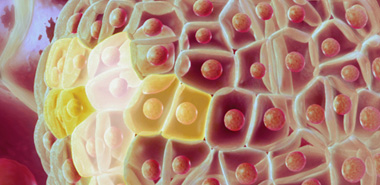来自新加坡基因组研究所(GIS)和细胞和分子生物学研究所(IMCB)的科学家发现了人类干细胞“百变”的秘密,而且只要启动这个被称为PRDM14的基因,任何普通细胞都有可能“变身”为干细胞,成功率比现有技术高三倍。该研究发表于10月17日的Nature杂志上。

拥有多能性(pluripotency)的胚胎干细胞(embryonic stem cell),能变成人体里200多种细胞中的任何一种,自我“繁殖”能力也强,因此一直被视为各种绝症的希望。不过,由于牵涉道德问题,胚胎干细胞研究一再受阻,科学家只好另觅良方。
科学人员近年就开始钻研“培育”多能性干细胞的可能性,通过重编程(re-programme)改变细胞基因,让普通细胞也具多能性。由19名本地科学家组成的研究小组就花了三年,从2万1000组基因中,找到了干细胞“多能性”的重要钥匙。
据称这是有史至今,最大规模的干细胞基因研究。
参与研究的新加坡基因组研究院高级研究小组组长黄学晖博士受访时指出,要让普通细胞具多能性,需启动的基因有好几组,PRDM14只是其中之一,但它却也扮演着重要角色。
小组发现,在改造细胞时如果为细胞“添置”PRDM14基因组,那最终培育出具多能性的细胞,将比平日多出三倍。
此外,他们也发现PRDM14只在人类的干细胞中扮演重要角色,对老鼠干细胞则不重要。这显示了不同物种间干细胞的差异,也再次彰显了以人类细胞进行研究的重要性。
黄博士说:“在此之前,研究员对人类胚胎干细胞的基因组合认识很少,多数试验室都专注用老鼠细胞进行研究。但了解人类干细胞其实很重要,如果不了解,我们又怎能研发新的科技。”
不过黄博士坦诚,目前还不清楚这项发现能如何应用于医药治疗。“除了PRDM14,我们目前还在研究很多其他的基因组。当中一些可能对个别病症具重要功能。”
“目前我们很难推算出一个时间表,正如很多重要的治疗,从发现到最终的临床应用是需要时间的。”
虽有人担心,重新编排细胞基因可能会启动不良副作用,但黄博士认为,随着更多关键基因获辨识,重新编排细胞基因的方式也将更完善。
黄博士表示,目前一些常见的干细胞疗法用的都是他人捐赠的干细胞,可是新的研究却能直接用病人本身的细胞“培育”出干细胞,仿佛是为病人“量身”制定,相信会更理想。
接下来,研究小组将继续探讨如何更好地为普通细胞“添置”PRDM14基因,以及如何利用基因学科技“指引”干细胞“变身”成为个别种类的细胞。(生物谷Bioon.com)
生物谷推荐英文摘要:
Nature advance online publication 17 October 2010 | doi:10.1038/nature09531
A genome-wide RNAi screen reveals determinants of human embryonic stem cell identity
Na-Yu Chia1,2,10, Yun-Shen Chan1,3,10, Bo Feng1,10, Xinyi Lu1,4, Yuriy L. Orlov5, Dimitri Moreau6, Pankaj Kumar6, Lin Yang1, Jianming Jiang1, Mei-Sheng Lau1, Mikael Huss5, Boon-Seng Soh7, Petra Kraus7, Pin Li7, Thomas Lufkin7, Bing Lim7,8, Neil D. Clarke5,9, Frederic Bard6,9 " Huck-Hui Ng1,2,3,4,9
The derivation of human ES cells (hESCs) from human blastocysts represents one of the milestones in stem cell biology1. The full potential of hESCs in research and clinical applications requires a detailed understanding of the genetic network that governs the unique properties of hESCs. Here, we report a genome-wide RNA interference screen to identify genes which regulate self-renewal and pluripotency properties in hESCs. Interestingly, functionally distinct complexes involved in transcriptional regulation and chromatin remodelling are among the factors identified in the screen. To understand the roles of these potential regulators of hESCs, we studied transcription factor PRDM14 to gain new insights into its functional roles in the regulation of pluripotency. We showed that PRDM14 regulates directly the expression of key pluripotency gene POU5F1 through its proximal enhancer. Genome-wide location profiling experiments revealed that PRDM14 colocalized extensively with other key transcription factors such as OCT4, NANOG and SOX2, indicating that PRDM14 is integrated into the core transcriptional regulatory network. More importantly, in a gain-of-function assay, we showed that PRDM14 is able to enhance the efficiency of reprogramming of human fibroblasts in conjunction with OCT4, SOX2 and KLF4. Altogether, our study uncovers a wealth of novel hESC regulators wherein PRDM14 exemplifies a key transcription factor required for the maintenance of hESC identity and the reacquisition of pluripotency in human somatic cells.
1Gene Regulation Laboratory, Genome Institute of Singapore, 60 Biopolis Street, Singapore 138672
2School of Biological Sciences, Nanyang Technological University, 60 Nanyang Drive, Singapore 637551
3Graduate School for Integrative Sciences " Engineering, National University of Singapore, 28 Medical Drive, Singapore 117456
4Dept of Biological Sciences, National University of Singapore, 14 Science Drive 4, Singapore 117543
5Computational and Systems Biology group, Genome Institute of Singapore, 60 Biopolis Street, Singapore 138672
6Institute of Molecular and Cell Biology, 61 Biopolis Drive, Proteos, Singapore 138673
7Stem Cell and Developmental Biology, Genome Institute of Singapore, 60 Biopolis Street, Singapore 138672
8Center for Life Sciences, Harvard Medical School, 330 Brookline Avenue, Boston, Massachusetts 02115, USA
9Department of Biochemistry, National University of Singapore, 8 Medical Drive, Yong Loo Lin School of Medicine, Singapore 117597
10These authors contributed equally to this work.







